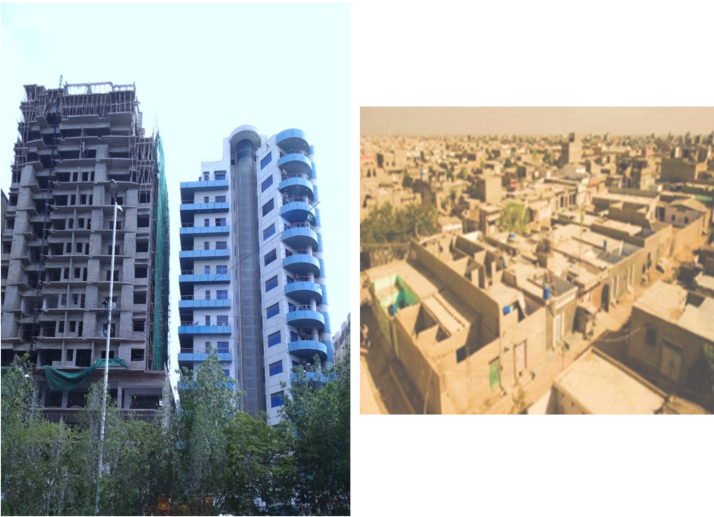Studio INTMA – 14- Autumn 2019
Tutor – Asiya Sadiq
Engagement: Legacy
Build Up or Build Out
Re-Imagining Habitats in a Hyper Transforming Context
Case of the Megapolis – Karachi – Pakistan
Habitats in Developing Contexts – In Brief
Habitat design projects in hyper transforming cities, in both the global south and north, are often designed in a top-down fashion and demonstrate a lack of research on the real needs of local communities. The current neo-liberal policies and projects are driven by investors’ interests, political agendas and large real estate returns. The housing in-appropriateness is also characterized by the inability of the local authorities to deal with the diversity and complexities of formal-informal interfaces, contextual legacies and hyper transformations in the society; as such, mega habitat projects often end up destroying existing socio-economic assets and processes.
Mega cities of the south with their ever-increasing populations, diminishing resources and the absence of state support turn towards the defacto informal sector for the provision of housing and other infrastructures. Within these dense and sprawling habitats there exists a thriving yet undocumented interface of formal and informal collective networks and space-making processes. However, due to a lack of political support and ambiguous policies, the interface remains undocumented and unrecognized, resulting in broader issues of; inaccessible housing, inappropriate typologies, socio-economic disparities, stigmatization, cultural nonassimilation, threatened legacies and disconnects with larger surrounding city plans.
The Karachi Studio aspires to answer these questions by engaging in critical research and design thinking. The process will take advantage of the INTMA 14 student group’s global/international outsider’s perspective whilst helping them to develop an insider’s insight for proposing appropriate and contextual design strategies and designs for distant realities such as Karachi. This studio experience has benefitted students of the past years to develop projects remotely, which are embedded in contextual realities yet can be objective and appropriate.
Karachi – The Megapolis – In Brief
By 2025, Karachi’s population will surpass 30 million. As more and more people make the city their home, it is becoming less and less hospitable – a paradox shared with many developing and developed world megacities. Like many large cities in the region, Karachi is vibrant, chaotic, polluted and overcrowded. Most of the city’s population is migrants, refugees, or their descendants. As they have settled the city, their struggle for homes and sustainable habitat continues.
The population of Karachi is housed both in the formal and informal realms, commonly known as, housing schemes (increasingly gated communities) and katchi abadis (informal settlements) which are separated in their spatial, social and cultural networks. However, there is a strong economic interdependence, as all enterprises, commercial and residential areas in the formal developments depend on the labor residing in the informal developments for the household to industrial, manufacturing and managerial and administrative services.
These interdependent habitats and their collective networks and spaces are most often spatially expressed in; streets and public spaces, commercial areas/ marketplaces, open spaces/parks, places of worship and formal sector higher education facilities. Interspersed amongst the formal (often rich to middle class) and informal
(lower-middle to poor class) realms, these provide a space of interaction amongst the different sections and classes of the city.
However, these habitats require reimagining as they are confronted with a hyper transforming situation, young and vibrant upwardly mobile populations with new/global aspirations and lifestyles, yet traditional family setups and limited resources creating the need for resilient, incremental and sustainable habitation solutions.
Karachi Studio – In Brief
The Karachi studio aims to:
Address the intricacies, complexities and contextual realities of designing in a hyper transforming context like Karachi
Situate the topic of designing housing in the global overarching debates of our times like; neoliberalism, land scarcity and density, climate change, migrations, increasing populations, decreasing resources and multiple disparities.
Propose Spatial strategies (architectural, urban design/development …….) to deal with the current challenges facing the profession and professionals
The proposed spatial strategies and designs should aspire to uncover and address
- Transforming socio-spatial relationships in traditional societies facing a hyper pace of change
- The private and public spatial interrelationships reflected in collective practices, spaces, and networks
- Issues of sustainability, resilience, and incrementality
- The integration of services and infrastructures as an integral part of habitat design
- Support to bottom-up, low cost and innovative practices
- Formal and informal interfaces in the design process, using it to propose new design typologies

